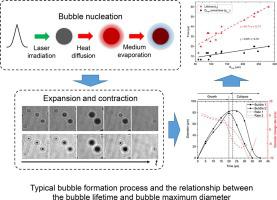当前位置:
X-MOL 学术
›
Exp. Therm. Fluid Sci.
›
论文详情
Our official English website, www.x-mol.net, welcomes your feedback! (Note: you will need to create a separate account there.)
Measurement of dynamics of laser-induced cavitation around nanoparticle with high-speed digital holographic microscopy
Experimental Thermal and Fluid Science ( IF 3.2 ) Pub Date : 2021-02-01 , DOI: 10.1016/j.expthermflusci.2020.110266 Linglong Wang , Yingchun Wu , Xuecheng Wu , Kefa Cen
Experimental Thermal and Fluid Science ( IF 3.2 ) Pub Date : 2021-02-01 , DOI: 10.1016/j.expthermflusci.2020.110266 Linglong Wang , Yingchun Wu , Xuecheng Wu , Kefa Cen

|
Abstract Micro/nano bubble formation on the surface of laser-irradiated nanoparticles has been widely studied in various industrial applications. The elucidation of the mechanism underlying cavitation induced by irradiating nanoparticles with laser is imperative. In this work, high-speed digital holographic microscopy is applied to visualize the in-situ dynamics of laser-induced bubbles generated on nanoparticles randomly dispersed in liquids. The growth and collapse of a bubble along its 3D trajectory are quantified. Experimental results show two patterns of bubble formation. One is that the maximum bubble wall speeds occur during either expansion or contraction. The other is that the maximum speeds are similar in both periods. It is found that the durations of growth and collapse are not equal, and their difference increases with the bubble maximum diameter, which is caused by altered heat transfer processes in bubbles. It implies large bubbles expand relatively quickly and shrink relatively slowly. This work will help understand the interaction among laser, nanoparticles and surrounding medium.
中文翻译:

用高速数字全息显微镜测量纳米粒子周围激光诱导空化的动力学
摘要 激光辐照纳米粒子表面微/纳米气泡的形成已在各种工业应用中得到广泛研究。阐明用激光照射纳米颗粒引起空化的机制势在必行。在这项工作中,高速数字全息显微镜用于可视化在随机分散在液体中的纳米粒子上产生的激光诱导气泡的原位动力学。气泡沿其 3D 轨迹的增长和崩溃被量化。实验结果显示气泡形成的两种模式。一是最大气泡壁速度发生在膨胀或收缩期间。另一个是两个时期的最大速度相似。发现增长和崩溃的持续时间不相等,它们的差异随着气泡最大直径的增加而增加,这是由气泡中的传热过程改变引起的。这意味着大气泡膨胀相对较快,收缩相对较慢。这项工作将有助于了解激光、纳米粒子和周围介质之间的相互作用。
更新日期:2021-02-01
中文翻译:

用高速数字全息显微镜测量纳米粒子周围激光诱导空化的动力学
摘要 激光辐照纳米粒子表面微/纳米气泡的形成已在各种工业应用中得到广泛研究。阐明用激光照射纳米颗粒引起空化的机制势在必行。在这项工作中,高速数字全息显微镜用于可视化在随机分散在液体中的纳米粒子上产生的激光诱导气泡的原位动力学。气泡沿其 3D 轨迹的增长和崩溃被量化。实验结果显示气泡形成的两种模式。一是最大气泡壁速度发生在膨胀或收缩期间。另一个是两个时期的最大速度相似。发现增长和崩溃的持续时间不相等,它们的差异随着气泡最大直径的增加而增加,这是由气泡中的传热过程改变引起的。这意味着大气泡膨胀相对较快,收缩相对较慢。这项工作将有助于了解激光、纳米粒子和周围介质之间的相互作用。



























 京公网安备 11010802027423号
京公网安备 11010802027423号